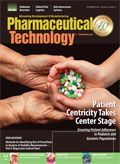News
Article
Pharmaceutical Technology
Growing Demand for Taste-Masking Technologies
Author(s):
Taste masking increases drug acceptability and medication adherence in pediatric, geriatric, and other special patient populations.
Billion Photos/shutterstock.com

Taste masking is a method used to improve not only the taste of bitter APIs in formulated drug products, but also mouth feel (smooth vs. gritty) and the overall acceptability of medications to patients. It can be achieved in various ways. Common methods include changing the API to a different form (e.g., drug freebase, salt, or pro-drug) that is less bitter; using sweeteners, buffers, taste modifiers, or aromas to reduce aversive sensory attributes; and complexing the API to prevent its interaction with taste receptors, such as with cyclodextrins and ion exchange resins. The API can be physically encapsulated through application of a coating (or coatings) to a drug particle or tablet, the use of barrier membranes, or the formation of solid dispersions via spray drying or hot-melt extrusion. Another potential method involves blocking of taste receptors directly or along the signaling pathway.
Taste masking is important because poor patient adherence often leads to worsening health and poor outcomes, along with increased costs across the healthcare system. A broader range of taste-masking technologies is required for the growing number of different dosage forms and drug-delivery approaches in use and under development today to meet the unique and specialized needs of different patient populations. Pediatric patients consist of subgroups from babies to teenagers, each with its own requirements. Geriatric patients may have difficulty swallowing. Patients with neurological conditions may resist taking medications if the drug product is not easy to take. Excipient manufacturers and service providers focused on taste masking are overcoming a range of challenges--from regulatory hurdles to an ability to accurately predict and measure taste-masking performance--to develop technologies suitable for the growing range of dosage forms and delivery systems.
Many drivers
The use of taste-masking technologies is driven by a number of factors that can be classified as regulatory, economic, demographic, and philanthropic, according to Jeff Worthington, president and founder of Senopsys. Regulations in the United States and European Union both require the development of pediatric medicines and the submission of detailed plans that outline the studies to be conducted as part of the pharmaceutical and clinical development programs. Unless a waiver is granted, pharmaceutical companies are required to develop pediatric formulations suitable for patients from birth to adolescence requiring age-appropriate dosage forms, such as liquids, orally dissolving films, fast dissolving tablets, granules (sprinkles), and mini-tablets, Worthington reports.
Tablets and capsules effectively bypass the taste receptors in the oral cavity, but most of the pediatric (and geriatric) dosage forms have residence times in the oral cavity, meaning the drug active can be perceived. Palatability, however, is essential to dosing compliance and adherence; therefore, regulatory agencies require that companies demonstrate the palatability of drug products in pediatric patient populations as part of the pharmaceutical and clinical development program. “Because many drug actives are bitter or have other aversive attributes including trigeminal irritation, malodor, and texture (e.g., grittiness), taste masking is required to ensure successful dose administration,” Worthington explains.
Non-governmental organizations also support the development of pediatric dosage forms for use in developing countries. Solid-dosage forms that permit flexible dosing (e.g., granules and mini-tablets) are preferred due to a variety of factors, including lack of potable water, complex logistics, and lack of refrigeration, according to Worthington.
Geriatric patients present additional adherence challenges. “This demographic group is often taking multiple medications and dosages provided by their caregivers; they also have a greater degree of challenges with swallowing and handling. Taste-masking is just one element that has to be considered,” according to Ali Rajabi-Siahboomi, vice-president and chief scientific officer of Colorcon.
Dosage forms other than conventional tablets and capsules-which may be difficult for older patients to swallow-need to be developed, adds Don Barbieri, technical product manager at SPI Pharma. He points to chewable tablets, dispersible powders, and orally disintegrating tablets as alternate dosage forms that can be administered to address swallowing difficulties. With orally dispersible products, however, there is a need for taste masking so that these dosage forms have acceptable palatability with little or no bitterness.
On the economic front, many of the growing number of drug candidates being developed to target orphan diseases, including many pediatric medicines, are often financially attractive due to premium pricing opportunities, market exclusivity, and priority regulatory reviews among other benefits; however, the formulations require taste masking, according to Worthington.
Numerous challenges
A number of hurdles must be overcome when developing taste-masking technologies that are effective. Top among them is achieving the necessary balance between preventing release of the API while the drug product is in the mouth but allowing for release once the medicine is in the stomach, according to Rajabi-Siahboomi. “The pharmacodynamics and pharmacokinetics (PK) cannot be effected by the taste-masking technology,” he says. The taste-masking technology must be appropriate for the extent of bitterness of the API, its solubility, and dosage level, as well as the dosage form (coated tablet, liquid, or granules to be distributed on food, etc.). In some cases, adding a sweetener or flavor is sufficient; in others, some type of barrier membrane must be used. Taste maskers that sequester the API from taste receptors (e.g., particle coating, adsorption, complexation), however, may adversely affect PK, leading to effective taste-masking but reduced bioavailability, according to Worthington.
Developers of taste-masking technologies also often work with APIs that have been incompletely or inaccurately characterized with respect to their aversive taste attributes because many APIs have multiple aversive taste attributes--such as bitter and sour basic tastes with trigeminal irritation--each of which may require a different mitigation approach, according to Worthington. In addition, he notes that the absence of a robust measurement system to provide quantitative data on the intensity and duration of aversive taste attributes makes optimization of taste-masking technologies difficult.
Poor correlation of in-vitro taste models (e.g., the electronic tongue with human data) often results in sub-optimal taste-masking and palatability issues, according to Worthington. There is also increasing regulatory pressure to reduce the number of excipients used in pediatric formulations, leading to the availability of fewer tools and lack of regulatory clarity on how specifically to approach pediatric formulation development. “For the most part, agencies have adopted a ‘propose-and-justify’ approach, rather than ascribing a defined process,” Worthington comments.
Modifying existing APIs through complexation to ionic exchange resins, while effective for taste masking, can present regulatory challenges, according to Barbieri. “In the United States, over-the-counter (OTC) monographed drugs can be marketed without further FDA approval. When an OTC monographed drug is attached to an ion-exchange resin, however, FDA considers the complexed drug to be a new compound that requires regulatory approval,” he explains.
Getting novel excipients of any kind approved for use in prescription medicines is also challenging because there is no separate approval pathway for excipients. A new excipient must be approved along with a formulated drug product, and often drug developers are hesitant to take on the added risk of using an excipient that has not already been proven acceptable to regulators.
On the production side, Barbieri notes that the use of solvents for the application of taste-masked polymer systems is an issue. “Aqueous systems are definitely preferred to avoid the additional testing that is required to quantify residual solvent levels and the added cost of handling and disposing of solvents,” he says.
Advancing taste-masking technology
Recent innovations in established taste-masking approaches have been incremental rather than breakthrough or novel technologies, according to Worthington. As an example, he notes that in particle coating there have been advances in barrier coatings used for taste masking that are better at balancing the need to maintain the target PK profile while minimizing particle size to minimize grittiness.
Senopsys applies expertise in sensory and formulation science garnered from the food industry to the development of palatable, patient-accepted drug products for its clients. These efforts include advances in the company’s quantitative FlavorMetrics Taste Assessment and FlavorOpt Taste Masking platforms and the development of methods for assessing the ease-of swallowing multi-particulate dosage forms (granules and mini-tablets), and a science-based approach to screening age-appropriate dosing vehicles for multi-particulate products. The company also is focused on the development of novel dosage forms to address unique dosing challenges, such as bars, chews, gummies, and ready-to-use puddings for high drug loading applications, according to Worthington.
SPI Pharma has developed a gelatin coacervation process as a new approach to taste masking of APIs. Originally introduced to manufacture carbonless copy paper, the process is performed in water without the need for solvents. The gelatin coating provides an excellent taste-masking barrier, and the resulting hydrogel film around the particle provides great mouth feel with smooth sensation and improved swallowability, according to Barbieri. “Interest in acetaminophen and ibuprofen taste masked with coacervated gelatin has increased significantly and, worldwide, more products are planned for introduction in the next one to two years,” he observes. Given the continuing increase in both interest and sales, SPI is actively evaluating other APIs that would be good candidates for taste masking via a coacervation process, according to Barbieri.
In addition to offering its established barrier membrane technology (Surelease/Opadry combination) and ion exchange resin (using DowDuPont AMBERLITE and DUOLITE) taste-masking solutions, Colorcon is working with BASF on the application of that company’s Kollicoat Smartseal, a novel, reverse enteric polymer that is highly stable in saliva and specifically soluble in gastric juice. It is being evaluated by Colorcon for inclusion in a film-coating system to simplify and accelerate coating operations and provide new options for taste masking of drug particles and granules. Colorcon also recognizes the industry need for a pigmented taste-masking solution to address the issues of differentiation and patient recognition. “However, because the polymer is a novel excipient, there is a real challenge to get it approved. We are working with some branded pharmaceutical companies who are evaluating its use in their formulations,” Rajabi-Siahboomi says.
Short-term expectations
As demand for taste masking increases further, the industry will look for ways to improve coating efficiency, reduce processing time, reduce waste, and maximize product yields, according to Barbieri. “Excipient manufacturers can be of benefit here by providing to pharmaceutical manufacturers a selection of different substrates for bead coating in a range of different particle sizes. The various core beads can be made to target specific particle size specifications and narrow particle size ranges. In this way, manufacturers can select the most appropriate seed product for their process without having to perform additional screening steps to sort out the inappropriate size beads, thereby facilitating manufacturing and reducing waste,” he comments.
To better support the application of its new taste-masking technologies and offerings, Colorcon is developing new methods for in-vitro testing using artificial saliva that will be truer tests and resemble what occurs within the body. They will be intended for use in conjunction with conventional dissolution testing. “There needs to be a mechanism for confirming that formulated products are indeed taste masked. Current dissolution testing methods don’t accurately model what is in the mouth,” says Rajabi-Siahboomi.
Worthington expects to see advances in barrier coatings in which these systems are combined with smaller particles to yield further improvements in palatability and swallowability. He also notes that further advances in 3D-printing may provide additional opportunities for taste masking as well as enable on-demand production of custom drug products.
Receptor disruption as a long-term solution?
Humans have approximately 30-40 known bitter taste receptors (many more than for sweet, sour, or salty); different compounds activate different sets of receptors. Efforts are underway to identify compounds that block bitter perception. Because individual compounds activate different sets of receptors, the prospect would appear greater for interrupting the common signaling pathway rather than a multiplicity of receptors, according to Worthington. “Regulatory agencies might consider these to be biologically active components at either the receptor or signaling pathway level, however, meaning that the bitter blockers would be regulated as drugs--or at best novel excipients--either way impeding adoption by industry,” he states. It is possible though, that basic research in taste perception may lead to future advances in taste-masking technology.
Article Details
Pharmaceutical Technology
Vol. 41, No. 11
Page: 24–27
Citation
When referring to this article, please cite it as C. Challener, “Growing Demand for Taste-Masking Technologies," Pharmaceutical Technology 41 (11) 2017.
Newsletter
Get the essential updates shaping the future of pharma manufacturing and compliance—subscribe today to Pharmaceutical Technology and never miss a breakthrough.





